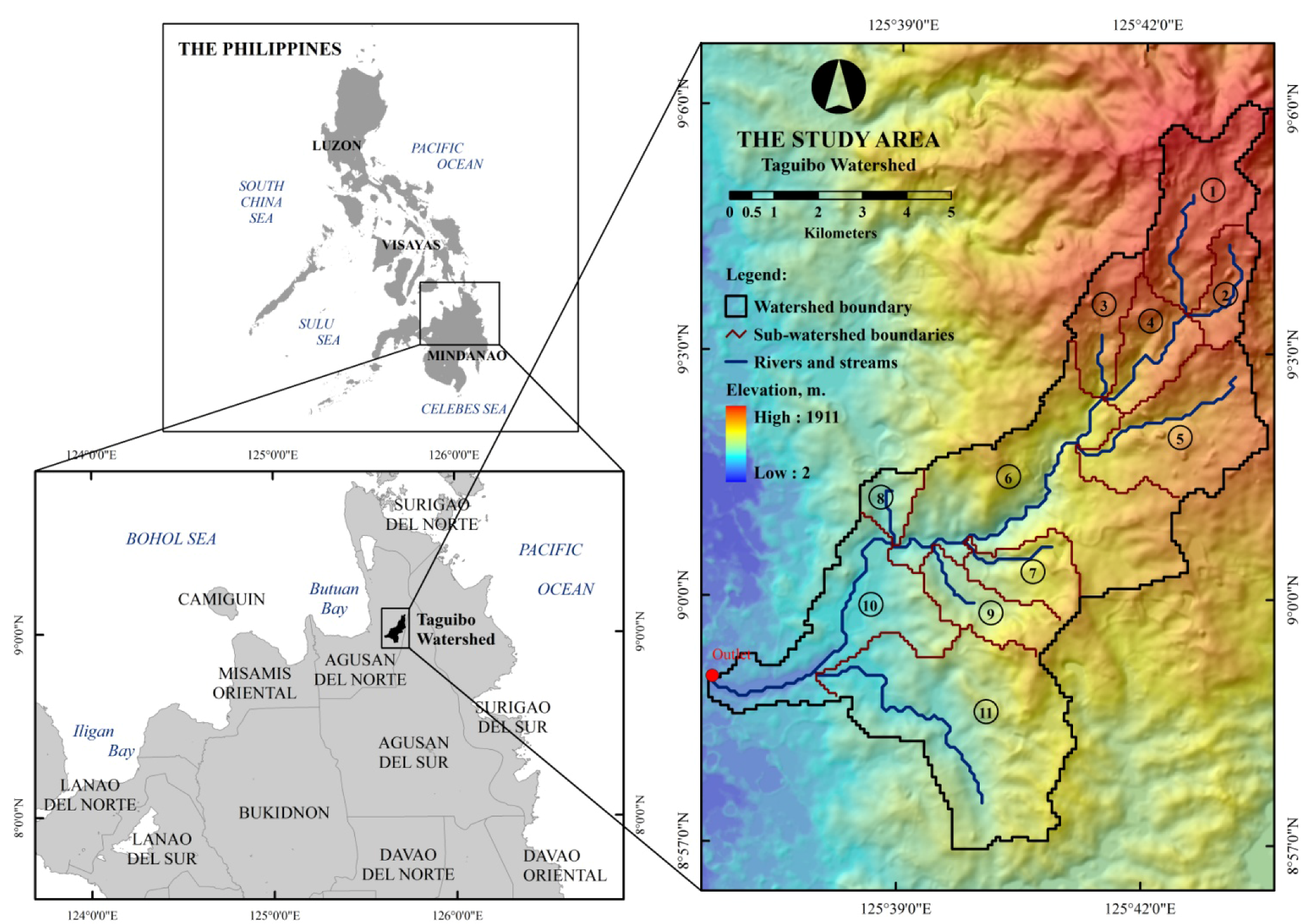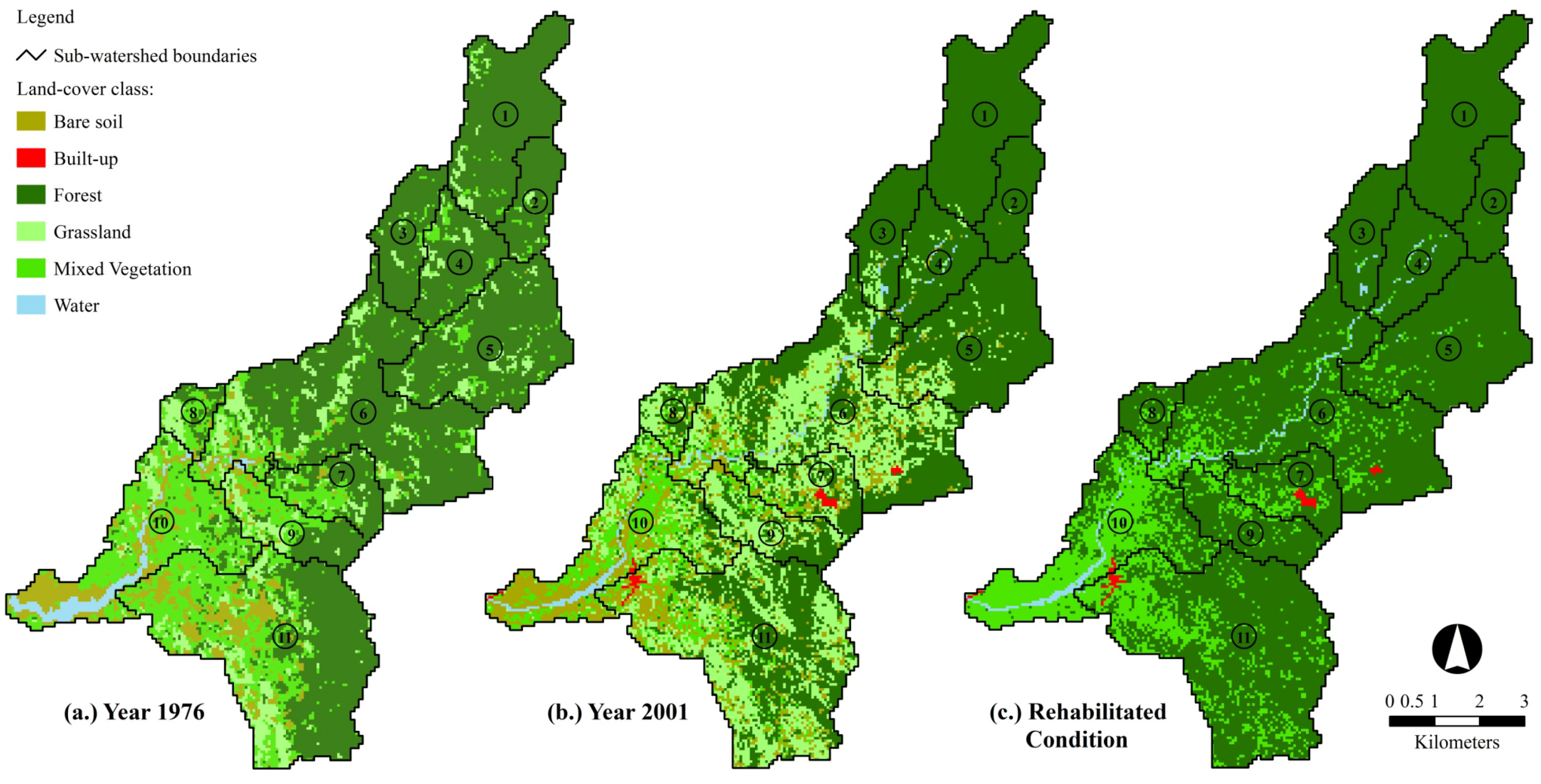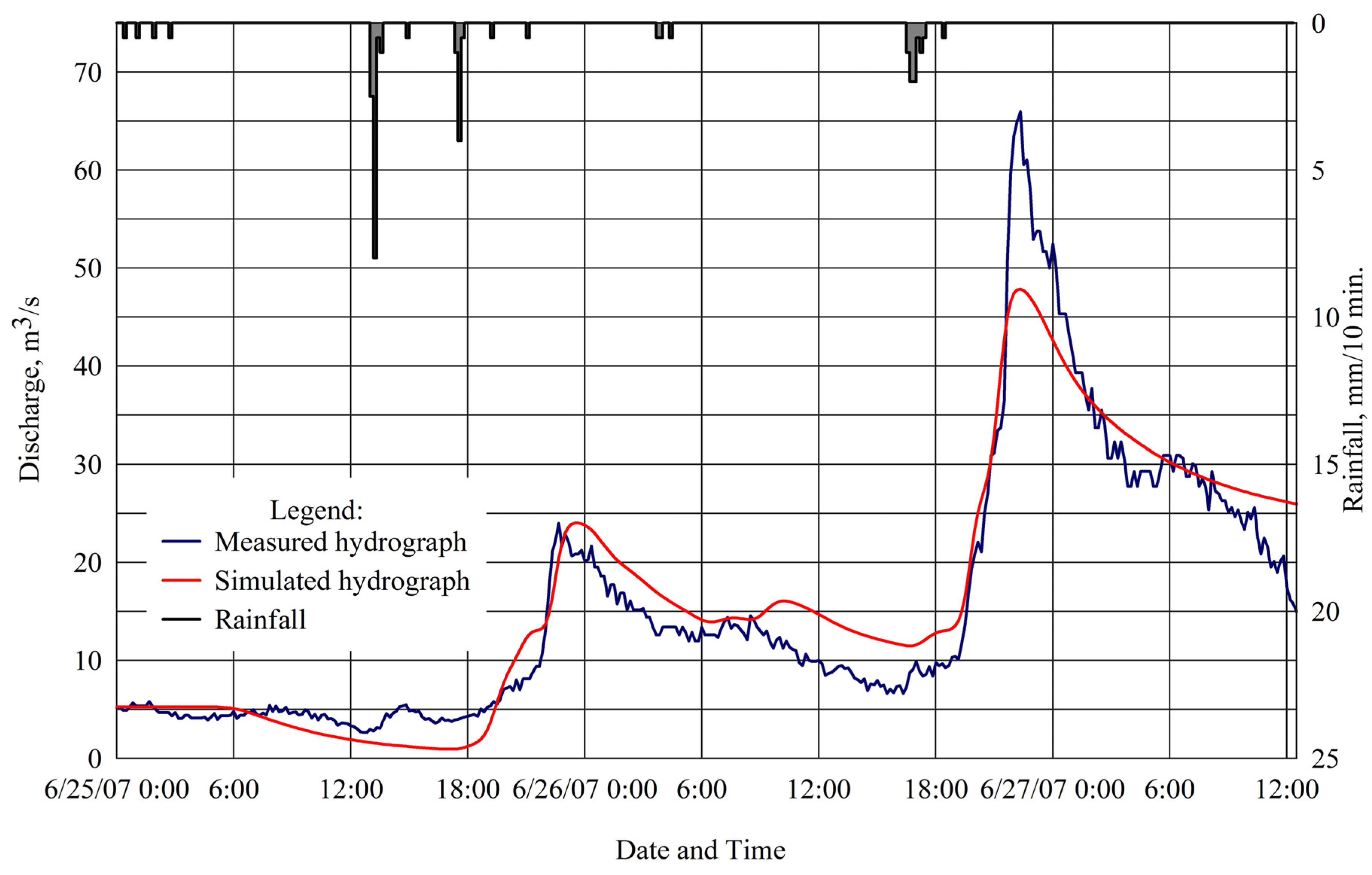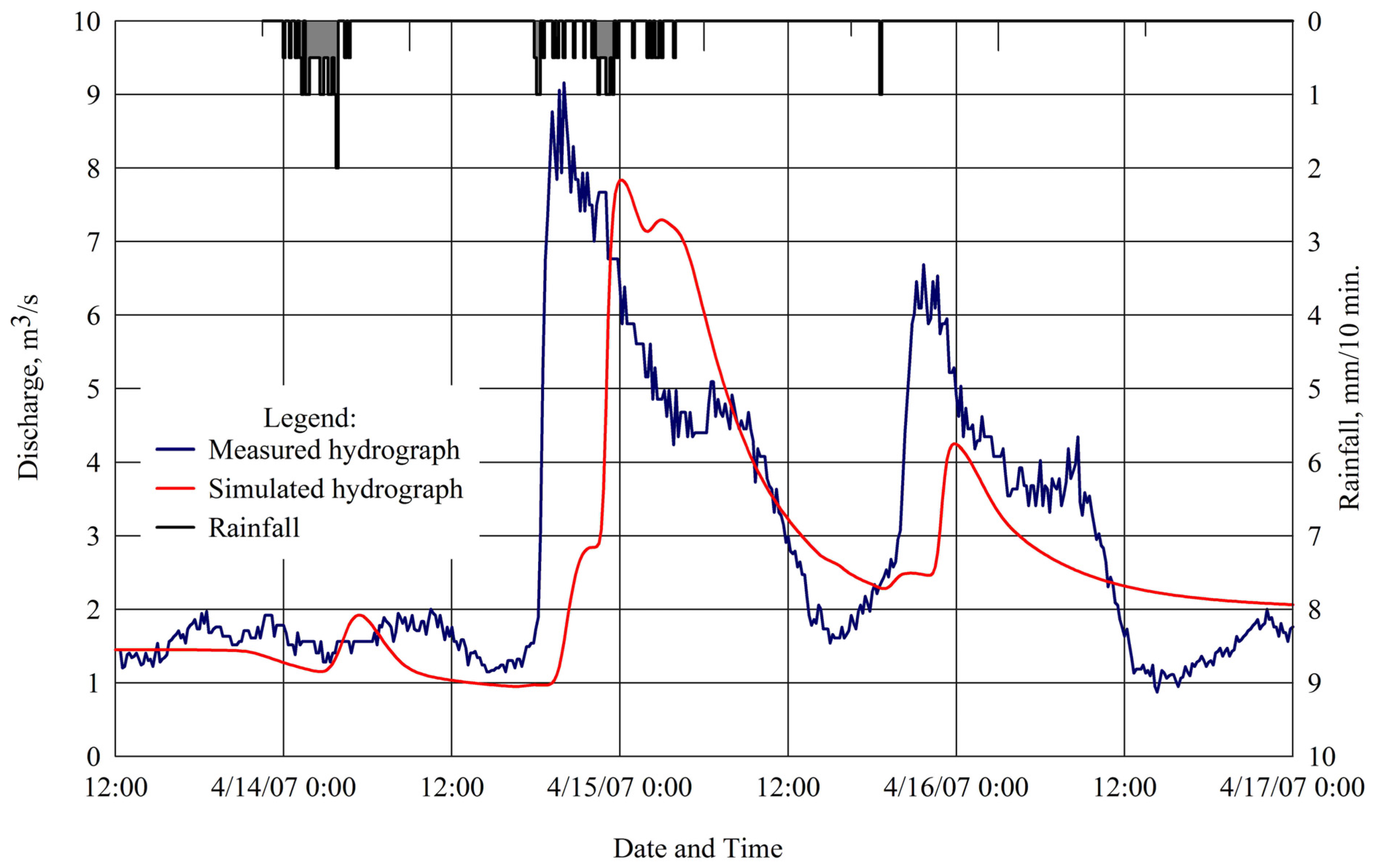Integrated Landsat Image Analysis and Hydrologic Modeling to Detect Impacts of 25-Year Land-Cover Change on Surface Runoff in a Philippine Watershed
Abstract
:1. Introduction
1.1. Motivations
1.2. Remote Sensing and GIS in Watershed Research

1.3. Objectives
2. Study Area
3. Methods
3.1. RS Change Detection
3.2. Landsat Image Pre-Processing
2.3. Image Classification and Land-Cover Change Detection
| Land-Cover Class | Number of Pixels for Classifier Training | Number of Pixels for Accuracy Assessment | ||
|---|---|---|---|---|
| 1976 Landsat MSS | 2001 Landsat ETM+ | 1976 Landsat MSS | 2001 Landsat ETM+ | |
| Barren Areas | 182 | 170 | 40 | 54 |
| Built-up Areas | - | 52 | - | 30 |
| Forest | 222 | 371 | 64 | 96 |
| Grassland | 122 | 220 | 62 | 91 |
| Mixed Vegetation | 139 | 149 | 58 | 54 |
| Water (along rivers and streams) | 168 | 92 | 30 | 48 |
3.2. Hydrologic Modeling
| Land-Cover | AMCII Curve Number (CN) | |
|---|---|---|
| Soil Group B | Soil Group D | |
| Barren areas | 86 | 94 |
| Built-up areas | 74 | 86 |
| Forest | 55 | 77 |
| Grassland | 61 | 80 |
| Mixed Vegetation | 58 | 79 |
| Water | 98 | 98 |
3.3. Runoff Predictions in Three Land-Cover Conditions
4. Results and Discussion
4.1. Image Classification Results

| Land-Cover Classes | 1976 Land-Cover Map | 2001 Land-Cover Map | ||
|---|---|---|---|---|
| PA | UA | PA | UA | |
| Barren areas | 92.50 | 94.87 | 98.15 | 92.98 |
| Built-up areas | - | - | 100.00 | 100.00 |
| Forest | 100.00 | 92.75 | 98.96 | 95.00 |
| Grassland | 98.39 | 98.39 | 94.51 | 100.00 |
| Mixed Vegetation | 93.10 | 98.18 | 100.00 | 100.00 |
| Water | 93.33 | 96.55 | 91.67 | 100.00 |
4.2. Land-Cover Change in the Taguibo Watershed
| Land-Cover Classes | 1976 Area (km2) | 2001 Area (km2) | % Change from 1976 with respect to total watershed area |
|---|---|---|---|
| Barren areas | 5.201 | 8.569 | +4.46 |
| Built-up areas | - | 0.300 | +0.40 |
| Forest | 46.287 | 41.366 | −6.52 |
| Grassland | 7.271 | 19.008 | +15.54 |
| Mixed Vegetation | 15.703 | 5.359 | −13.69 |
| Water | 1.070 | 0.930 | −0.19 |
4.2. Hydrologic Model Calibration and Validation Results


4.3. Runoff Predictions in 3 Land-Cover Conditions
| SW | 1976 Condition | 2001 Condition | Rehabilitated Condition | ||
|---|---|---|---|---|---|
| Runoff | % Change | Runoff | Runoff | % Change | |
| Volume | From 2001 | Volume | Volume | From 200 | |
| (x103 m3) | Condition | (x103 m3) | (x103 m3) | Condition | |
| 1 | 83.938 | 0.73 | 83.332 | 83.292 | −0.05 |
| 2 | 20.097 | 1.11 | 19.876 | 19.854 | −0.11 |
| 3 | 18.055 | −7.16 | 19.447 | 18.626 | −4.22 |
| 4 | 31.948 | −3.96 | 33.267 | 32.390 | −2.64 |
| 5 | 76.882 | −7.61 | 83.217 | 75.977 | −8.70 |
| 6 | 39.588 | −32.35 | 58.520 | 35.866 | −38.71 |
| 7 | 7.868 | −37.70 | 12.631 | 7.106 | −43.74 |
| 8 | 3.078 | −12.89 | 3.533 | 1.895 | −46.36 |
| 9 | 7.632 | −12.87 | 8.759 | 4.433 | −49.39 |
| 10 | 37.138 | −10.21 | 41.363 | 12.061 | −70.84 |
| 11 | 50.547 | −12.24 | 57.596 | 29.494 | −48.79 |
| Total | 376.771 | 421.540 | 320.996 | ||

| SW No. | Area (km2) | % Change in Barren Areas | % Change in Forest | % Change in Grassland | % Change in Mixed Vegetation |
|---|---|---|---|---|---|
| 1 | 7.16 | 0.00 | 6.385 | −4.065 | −2.32 |
| 2 | 2.519 | 0.13 | 6.923 | −2.236 | −4.815 |
| 3 | 3.175 | 0.64 | −2.491 | 4.688 | −4.634 |
| 4 | 3.637 | 1.79 | 8.868 | −4.332 | −8.823 |
| 5 | 8.748 | 3.80 | −3.682 | 5.907 | −6.204 |
| 6 | 16.483 | 7.28 | −26.946 | 27.053 | −8.964 |
| 7 | 3.224 | 12.52 | −18.218 | 25.93 | −23.512 |
| 8 | 1.531 | 2.90 | 8.102 | 17.8 | −28.146 |
| 9 | 3.459 | 2.71 | 1.912 | 24.051 | −27.818 |
| 10 | 9.056 | 9.01 | 3.379 | 13.639 | −21.119 |
| 11 | 16.54 | 2.39 | −5.658 | 23.837 | −21.204 |
| Land-cover condition | Accumulated watershed runoff volume, ×103 m3 | % Difference from the 2001 condition |
|---|---|---|
| 1976 | 376.771 | −10.62% |
| 2001 (reference) | 421.540 | |
| Rehabilitated | 320.996 | −23.85% |
5. Conclusions
Acknowledgements
References
- McColl, C.; Aggett, G. Land-use forecasting and hydrologic model integration for improved land-use decision support. J. Environ. Manage. 2007, 84, 494–512. [Google Scholar] [CrossRef] [PubMed]
- Cebecauer, T.; Hofierka, J. The consequences of land-cover changes on soil erosion distribution in Slovakia. Geomorphology 2008, 98, 187–198. [Google Scholar] [CrossRef]
- DENR. Taguibo River Watershed Management Plan; Department of Environment and Natural Resources: Butuan City, Agusan del Norte, Philippines, 2003. [Google Scholar]
- Engman, E.T. Remote sensing applications to hydrology: Future impact. Hydrol. Sci. 1996, 41, 637–647. [Google Scholar] [CrossRef]
- Engman, E.T. The use of remote sensing data in watershed research. J. Soil Water Conserv. 1995, 50, 438. [Google Scholar]
- Bach, H.; Braun, M.; Lampart, G.; Mauser, W. Use of remote sensing for hydrological parameterisation of Alpine catchments. Hydrol. Earth Syst. Sci. 2003, 7, 862–876. [Google Scholar] [CrossRef]
- Melesse, A.M.; Shih, S.F. Spatially distributed storm runoff depth estimation using Landsat images and GIS. Comput. Electron. Agric. 2002, 37, 173–183. [Google Scholar] [CrossRef]
- Pandey, A.; Chowdary, V.M.; Mal, B.C.; Billib, M. Runoff and sediment yield modeling from a small agricultural watershed in India using the WEPP model. J. Hydrol. 2008, 348, 305–319. [Google Scholar] [CrossRef]
- Bhuyan, S.J.; Koelliker, J.K.; Marzen, L.J.; Harrington, J.A. An integrated approach for water quality assessment of a Kansas watershed. Environ. Model. Softw. 2003, 18, 473–484. [Google Scholar] [CrossRef]
- O’Connell, P.E.; Ewen, J.; O’Donnell, G.; Quinn, P. Is there a link between agricultural land-use management and flooding? Hydrol. Earth Syst. Sci. 2007, 11, 96–107. [Google Scholar] [CrossRef]
- Vafeidis, A.T.; Drake, N.A.; Wainwright, J. A proposed method for modelling the hydrologic response of catchments to burning with the use of remote sensing and GIS. Catena 2007, 70, 396–409. [Google Scholar] [CrossRef]
- Helmschrot, J.; Flügel, W. Land use characterisation and change detection analysis for hydrological model parameterisation of large scale afforested areas using remote sensing. Phys. Chem. Earth 2002, 27, 711–718. [Google Scholar] [CrossRef]
- LeBlanc, M.J.; Favreau, G.; Massuel, S.; Tweed, S.O.; Loireau, M.; Cappelaere, B. Land clearance and hydrological change in the Sahel: SW Niger. Glob. Planetary Change 2008, 61, 135–150. [Google Scholar] [CrossRef]
- Niehoff, D.; Fritsch, U.; Bronstert, A. Land-use impacts on storm-runoff generation: Scenarios of land-use change and simulation of hydrological response in a meso-scale catchment in SW-Germany. J. Hydrol. 2002, 267, 80–93. [Google Scholar] [CrossRef]
- SCS. National Engineering Handbook, Section 4: Hydrology; US Department of Agriculture, Soil Conservation Service: Washington, DC, USA, 1985.
- Coppin, P.; Jonckheere, I.; Nackaerts, K.; Muys, B. Digital change detection methods in ecosystem monitoring: A review. Int. J. Remote Sens. 2004, 25, 1565–1596. [Google Scholar] [CrossRef]
- Jensen, J.R. Introductory Digital Image Processing: A Remote Sensing Perspective; Prentice-Hall: Upper Saddle River, NJ, USA, 2004. [Google Scholar]
- Cherill, A.J.; Lane, A.; Fuller, R.M. The use of classified Landsat 5 Thematic Mapper imagery in the characterization of landscape composition: A case study in Northern England. J. Environ. Manage. 1994, 40, 357–377. [Google Scholar] [CrossRef]
- Cingolani, A.M.; Renison, D.; Zak, M.R.; Cabido, M.R. Mapping vegetation in a heterogeneous mountain rangeland using Landsat data: An alternative method to define and classify land-cover units. Remote Sens. Environ. 2004, 92, 84–97. [Google Scholar] [CrossRef]
- Hagner, O.; Reese, H. A method for calibrated maximum likelihood classification of forest types. Remote Sens. Environ. 2007, 110, 438–444. [Google Scholar] [CrossRef]
- Swain, P.H.; Davis, S.M. Remote Sensing: The Quantitative Approach; McGraw-Hill: New York, NY, USA, 1978. [Google Scholar]
- Muttitanon, W.; Tripathi, N.K. Land use/land cover changes in the coastal zone of Ban Don Bay, Thailand using Landsat 5 TM data. Int. J. Remote Sens. 2005, 26, 2311–2323. [Google Scholar] [CrossRef]
- Chowdhury, R. Landscape change in the Calakmul Biosphere Reserve, Mexico: Modeling the driving forces of smallholder deforestation in land parcels. Appl. Geogr. 2006, 26, 129–152. [Google Scholar] [CrossRef]
- Vagen, T.G. Remote sensing of complex land use change trajectories—A case study from the highlands of Madagascar. Agr. Ecosyst. Environ. 2006, 115, 219–228. [Google Scholar] [CrossRef]
- Huang, C.; Davis, L.S.; Townshend, J.R.G. An assessment of support vector machines for land cover classification. Int. J. Remote Sens. 2002, 23, 725–749. [Google Scholar] [CrossRef]
- Shuying, J.; Deren, L.; Jingwen, W. A Comparison of Support Vector Machine with Maximum Likelihood Classification Algorithms on Texture Features. In Proceedings of IEEE International Geoscience and Remote Sensing Symposium, Soeul, Korea, 25–29 July 2005; Volume 5, pp. 3717–3720.
- Otukei, J.R.; Blaschke, T. Land cover change assessment using decision trees, support vector machines and maximum likelihood classification algorithms. Int. J. Appl. Earth Obs. Geoinf. 2010, 12, S27–S31. [Google Scholar] [CrossRef]
- Foody, G.M.; Mathur, A. Relative evaluation of multiclass image classification by Support Vector Machines. IEEE Trans. Geosci. Remote Sens. 2002, 42, 1335–1343. [Google Scholar] [CrossRef]
- Markham, B.L.; Barker, J.L. Landsat MSS and TM Post-Calibration Dynamic Ranges, Exoatmospheric Reflectances and at-Satellite Temperatures; EOSAT Landsat Technical Notes No. 1; EOSAT: Lanham, MD, USA, 1986. [Google Scholar]
- NASA. Landsat-7 Science Data User’s Handbook. Available online: http://landsathandbook.gsfc.nasa.gov/handbook.html (accessed on 15 April 2008).
- Schowengerdt, R.A. Remote Sensing: Models and Methods for Image Processing; Academic Press: San Diego, CA, USA, 1997. [Google Scholar]
- Anderson, J.R.; Hardy, E.E.; Roach, J.T.; Witmer, R.E. A Land Use and Land Cover Classification System for Use with remote Sensor Data; USGS Professional Paper 964; US GPO: Washington, DC, USA, 1976.
- Mather, P.M. Computer Processing of Remotely-Sensed Images, 2nd ed.; Wiley: New York, NY, USA, 1999. [Google Scholar]
- Richards, J.A.; Jia, X. Remote Sensing Digital Image Analysis: An Introduction; Springer: Berlin, Germany, 1999. [Google Scholar]
- Van Genderen, J.L.; Lock, B.F.; Vass, P.A. Remote sensing: statistical testing of thematic map accuracy. Remote Sens. Environ. 1978, 7, 3–14. [Google Scholar] [CrossRef]
- Congalton, R.G.; Green, K. Assessing the Accuracy of Remotely Sensed Data: Principles and Practices; Lewis Publishers: Boca Rotan, FL, USA, 1999. [Google Scholar]
- Ponce, V.M.; Hawkins, R.H. Runoff curve number: Has it reached maturity? J. Hydrol. Eng. 1996, 1, 11–19. [Google Scholar] [CrossRef]
- Chow, V.T.; Maidment, D.R.; Mays, L.W. Applied Hydrology; McGraw-Hill: New York, NY, USA, 1988. [Google Scholar]
- USACE. Hydrologic Modeling System HEC-HMS Technical Reference Manual; US Army Corps of Engineers, Hydrologic Engineering Center: Davis, CA, USA, 2000.
- USACE. Geospatial Hydrologic Modelling Extension HEC-GeoHMS User’s Manual; Version 1.1; US Army Corps of Engineers, Hydrologic Engineering Center: Davis, CA, USA, 2003.
- Nelder, J.A.; Mead, R. A simplex method for function minimization. The Comput. J. 1965, 7, 308–313. [Google Scholar] [CrossRef]
- Nash, J.E.; Sutcliffe, J.V. River flow forecasting through conceptual models, I—A discussion of principles. J. Hydrol. 1970, 10, 282–290. [Google Scholar] [CrossRef]
- Moriasi, D.N.; Arnold, J.G.; Van Liew, M.W.; Bingner, R.L.; Harmel, R.D.; Veith, T.L. Model evaluation guidelines for systematic quantification of accuracy in watershed simulations. Trans. ASABE 2007, 50, 885–900. [Google Scholar] [CrossRef]
- Van den Top, G.M. The Social Dynamics of Deforestation in the Sierra Madre, Philippines; NIASS Press: Amsterdam, The Netherlands, 1998. [Google Scholar]
- Verburg, P.H.; Veldkamp, A. Projecting land use transitions at forest fringes in the Philippines at two spatial scales. Landscape Ecol. 2004, 19, 77–98. [Google Scholar] [CrossRef]
- Mishra, S.K.; Sahu, R.K.; Eldho, T.I.; Jain, M.K. An improved Ia-S relation incorporating antecedent moisture in SCS-CN methodology. Water Resour. Manage. 2006, 20, 643–660. [Google Scholar] [CrossRef]
- Costa, M.H.; Botta, A.; Cardille, J.A. Effects of large-scale changes in land cover on the discharge of the Tocantins River, Southeastern Amazonia. J. Hydrol. 2003, 283, 206–217. [Google Scholar] [CrossRef]
- Siriwardena, L.; Finlayson, B.L.; McMahon, T.A. The impact of land use change on catchment hydrology in large catchments: The Comet River, Central Queensland, Australia. J. Hydrol. 2006, 326, 199–214. [Google Scholar] [CrossRef]
© 2011 by the authors; licensee MDPI, Basel, Switzerland. This article is an open access article distributed under the terms and conditions of the Creative Commons Attribution license (http://creativecommons.org/licenses/by/3.0/).
Share and Cite
Santillan, J.; Makinano, M.; Paringit, E. Integrated Landsat Image Analysis and Hydrologic Modeling to Detect Impacts of 25-Year Land-Cover Change on Surface Runoff in a Philippine Watershed. Remote Sens. 2011, 3, 1067-1087. https://doi.org/10.3390/rs3061067
Santillan J, Makinano M, Paringit E. Integrated Landsat Image Analysis and Hydrologic Modeling to Detect Impacts of 25-Year Land-Cover Change on Surface Runoff in a Philippine Watershed. Remote Sensing. 2011; 3(6):1067-1087. https://doi.org/10.3390/rs3061067
Chicago/Turabian StyleSantillan, Jojene, Meriam Makinano, and Enrico Paringit. 2011. "Integrated Landsat Image Analysis and Hydrologic Modeling to Detect Impacts of 25-Year Land-Cover Change on Surface Runoff in a Philippine Watershed" Remote Sensing 3, no. 6: 1067-1087. https://doi.org/10.3390/rs3061067
APA StyleSantillan, J., Makinano, M., & Paringit, E. (2011). Integrated Landsat Image Analysis and Hydrologic Modeling to Detect Impacts of 25-Year Land-Cover Change on Surface Runoff in a Philippine Watershed. Remote Sensing, 3(6), 1067-1087. https://doi.org/10.3390/rs3061067




